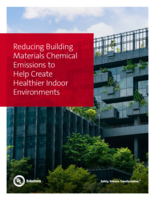
GREENGUARD for Building Materials Whitepaper
Learn how UL GREENGUARD Certification, offered only by UL Solutions, empowers building materials manufacturers to showcase their commitment to improving IAQ with products that meet criteria for low chemical emissions.

Because we spend about 90% of our lives indoors1, the air quality in our homes, offices, schools and other indoor environments can significantly impact our health, well-being and productivity. Volatile organic compounds (VOCs) commonly found in building materials — including paint, flooring and insulation materials — greatly contribute to indoor air pollution levels.
Improving indoor air quality (IAQ) can reduce respiratory disease, allergies, asthma and sick building syndrome and even boost work performance. Considering these clear benefits of reducing indoor pollutants, building codes and ordinances, as well as green building programs around the world, require building materials to meet criteria for low VOC emissions. Companies that do not comply with codes and ordinances risk facing fines and brand damage, but a lack of clear information about how to meet requirements often prevents companies from moving forward to compliance.
In this white paper, UL Solutions experts provide building materials and commercial furniture manufacturers with insight into IAQ issues in relation to building materials and commercial furniture products. We discuss how certification programs can support manufacturers’ efforts to substantiate legitimate claims for their products with reduced environmental impact. We begin by reviewing the causes and effects of poor IAQ and the common types of VOCs that can adversely impact human health. We then summarize the current state of product certification programs that address IAQ and discuss the UL GREENGUARD Certification program.
Finally, we provide an overview of the UL GREENGUARD Certification process and discuss the advantages of UL GREENGUARD Certification.
Source

GREENGUARD for Building Materials Whitepaper
Thanks for your interest in our products and services. Let's collect some information so we can connect you with the right person.